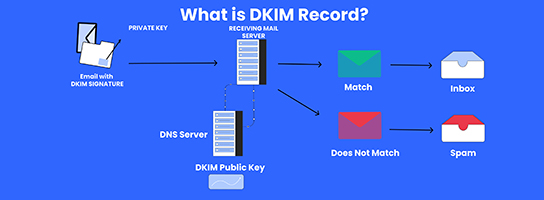What is DKIM Record?

What is DKIM?
DomainKeys Identified Mail (DKIM) is an email authentication procedure that allows email senders to digitally sign their messages using cryptographic techniques to verify their identity and prevent message counterfeiting.
How DKIM works
Public-key cryptography is used by DKIM to confirm that a message was delivered by the stated sender and was not altered while in transit. A public/private key pair is generated by the sender’s domain, and the public key is made available via the DNS. The private key is used by the sender’s mail server to create a digital signature for each email that is sent. The message’s headers are then changed to incorporate the signature and some related information, such as the selector and algorithm used.
As a result, the recipient’s mail server can be certain that the message was delivered by the claimed sender and that it was not tampered with during transit by using the sender’s public key to verify the signature.
DKIM is intended to work with existing email infrastructure and can be used by any organization that sends email. It works particularly effectively for large enterprises with numerous mail servers and for emails that are forwarded through several servers before arriving at their intended recipient.
What is a DKIM record?
The DKIM public key, which is a random string of characters needed to verify anything signed with the private key, is kept in a DKIM record. To view the DKIM record and public key, email servers look for the domain’s DNS records.
A DNS TXT record is what a DKIM record actually is. Any text that a domain administrator wants to associate with their domain can be stored in TXT records. One use for this kind of DNS entry is DKIM.
What to consider before creating the DKIM record?
- Find out which domains are permitted to send outbound mail on its behalf in step
- Produce the DKIM policy record and public/private keys. Your public-facing DNS TXT record will employ the “public” key along with another record known as a “policy record.”
- Using the DKIM data produced by these wizards, construct TXT entries. Include DKIM records for each and every one of your relevant transmitting domains. Your public-facing DNS record for each sending domain will contain these records. Public key records and policy records are the two main types of DNS records that Domain Keys uses.
- Verify that your current MTAs for transmission support DKIM. If not, upgrade them so that DKIM functionality is available. The sending MTAs are your outbound mail flow’s final point of contact, and this is where DKIM signatures are added to the outgoing messages. The message content and specific header fields can both be signed by an agent along the message transit path. The RFC2822 message header contains a field where the signature data is inserted.
Is a DKIM record required?
A DKIM record is not required to send an email with Gmail. Gmail uses SPF to authenticate messages. If you want to use DKIM to sign your messages, you must set up DKIM in your email server.
Why do you need a DKIM record?
DKIM offers a digital signature and encryption key that confirms that an email message was not altered or fabricated. Deliverability of your emails will be substantially more secure if DKIM is performed correctly. Your recipients will have higher faith in your domain because of the DKIM record. No spoofing or phishing scams will be launched on your behalf. By doing this, you can ensure the security of your recipients and the good standing of your domain. The DKIM record secures the mail server for your domain, and you can combine it with other DNS entries, such as DMARC, for even more security. Additionally, making it is really simple.
Read about how to Create a DKIM Record
Conclusion
Skysnag automates DMARC, SPF, and DKIM for you to increase email deliverability. With that being said, avoid email spoofing attacks with Skysnag’s automated software which allows you to confirm the validity of emails. Sign up using this link for a free trial today and ensure your organization’s DKIM records are configured correctly.





